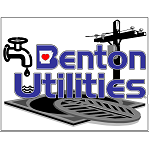The Benton Public Utilities Commission Meeting will hold their regular meeting Monday, May 20th at 6 p.m. at 1827 Dale St in Benton. The agenda follows.
AGENDA
1. Call to Order
2. Prayer
3. Pledge of Allegiance
4. Roll Call
5. Approval of Minutes from the Regular Meeting of May 6, 2019. (See minutes text below)
6. City Council Report
A. Storm Water Fee: Alderman James Herzfeld
7. Departmental Reports
A. Finance: April financials Cindy Hawkins
B. Engineering: Project Updates Jacob Gillip, MCE
C. Water Treatment: Storage Tank Cleaning Services Steve Robbins
D. Automatic Transfer Switches: Water Plant Steve Robbins
8. Old Business
A. Legal updates from City Attorney David Vondran
9. New Business
A. Billing Services: Lane Commercial Equipment Deposit David Vondran
10. Announcements
A. Next Commission meeting date: Monday, June 3, 2019, 6 p.m.
11. Executive Session
MINUTES FROM MAY 6, 2019 BENTON UTILITY COMMISSIONERS MEETING
The City of Benton Utility Commissioners met in regular session Monday, May 6, 2019, at the Electric Utility Building, 1827 Dale Avenue.
In Attendance:
- Gary Ferrell, Chairman
- Charlie Best, Member
- Jim Martin, Member
- Doug Stracener, Member
- Phil Miller, Member
Chairman Ferrell called the meeting to order with all members in attendance.
Member Martin gave the invocation and Member Miller led the Pledge of Allegiance.
The first item of business was approval of the minutes from the regular meeting of April 15, 2019.
Member Best made a motion to approve the minutes as presented.
Member Miller seconded the motion.
A vote was taken, and unanimous approval given.
DEPARTMENTAL REPORTS
Wastewater Treatment Replacement Pump for Effluent Wash Water – Jonathan Buff
Mr. Buff gave each of the commissioners a handout and said they had previously talked about both items that he is bringing up, but he has a little bit more information on them.
The first page is the Benton Process Washwater Pump Station and you can see the schematic there.
This is the project they had done in 2011 or so.
McClelland designed this, Heller came in and did the work and we put it in.
He thinks it had a pretty good payback overall, but they ran in to some problems.
On page 2 you can kind of see how the pumps are laid out between the building and the wet well.
If you look really close you will see that the skid did not go all the way to include the motor and the gear box.
There is a 60HP motor sitting out there on that gear box.
Every time he took the gear box to the shop, they tell him it’s on the motor side.
All together between the motor, pumps and everything he has probably spent close to $15,000 since these things were installed just for the upkeep of the pumps.
Both pumps are down right now, and he has kind of gone out and gotten the price for parts and the parts are as much as what a new pump would cost.
He started questioning it and working with Adam at McClelland real close.
Jacob is here tonight to answer any questions you may have.
What we decided to do is to look at this and see if there wasn’t a different pump that we could use in this application that might be more efficient and better.
His biggest concern is owning something that doesn’t cost as much to maintain if they have to rebuild it later on.
If you look at the 2 schematics, the first shows the existing layout and the second shows what we are proposing; which is a vertical turbine.
It is about 83% efficient, meets the flow demand and is a pretty easy installation with just some piping and they won’t have to put a rail system in.
McClelland has looked at this and we have concluded that this is the best solution.
He thinks they will get a longer life out of the pumps than what they did with Neztsch.
Byron Hicks, with McClelland Engineers said it’s not that the progressive cavity that is in there is a bad design, but he doesn’t think the gear box was designed right and he certainly doesn’t think it has the right support on it.
Mr. Buff said even Neztsch didn’t want to send the parts.
They wanted to send him the vertical type of unit.
They will still have to look at the cost of rebuilding these in the future.
We went out and looked at several other facilities in Little Rock, Hot Springs, Rogers and several other places that are using the vertical turbines.
Their applications are a little different than ours.
They are using multiple pumps for their flow demand, whereas we have designed ours to use 1 pump for our flow demand.
Some are using 3 pumps to meet their flow demand and some facilities like Springdale are using smaller pumps and using them together so there is not redundancy if they lose one pump.
They are using some smaller pumps for irrigation outside of their property.
Rogers is using smaller pumps to irrigate the golf course, but those pumps will run and then shut off.
We are using these pumps 24/7.
Member Martin asked what the problems he has had with them and Mr. Buff said the gear box has been the biggest problem he has had.
He has also had to have the motors worked on, but he is not sure if that was due to the gear box or not.
He has had to buy a stater.
The rotor and stater alone are almost $15,000.
The stater was $2,500 and the rotor was $11,000 to $12,000.
Between the pump and gear box is a little bitty knuckle piece that goes in there that is about $2,500.
It has been a maintenance nightmare.
Member Martin asked if these are suction pumps and Mr. Buff said they are cavity pumps.
We have kind of looked at these and if you have any technical issues Jacob Gillip is here to answer those.
Mr. Buff is here tonight to let the Commission know he has a full set of specifications now and McClelland has emailed that to Ms.
Linda McAdoo, Procurement Manager.
He wants to go out for bids since this is a different type of pump than they originally had and have changed the design up a little bit.
He asked if they would have to have the Health Department’s approval and Mr. Gillip said he didn’t ask him about that.
Mr. Buff said Adam told him he would check.
Mr. Gillip said Adam did not mention it, but he would think that if just the pump is being replaced.
Chairman Ferrell said there has to be a little piping change and Mr. Gillip said a little bit.
Chairman Ferrell asked what the estimated value is, and Mr. Gillip said the materials are going to be approximately $30,000 for 1 pump.
Mr. Buff said they went out and got 2 budgetary quotes; one was priced at $29,000 to $30,000 and the other was $35,000.
One was a 5 stage like the specs right now and the other was a 7-stage vertical turbine.
Member Martin asked if they would do away with the gear box when they go vertical and Mr. Buff said yes, they would just have piping ran from the pump.
Everything you see there between the wet well and building will just be piping.
They will do all of that in house.
They would like to go out for bid.
Mrs. McAdoo said all together it will take 3 to 4 weeks from start to finish for the bidding process.
Member Martin asked if they would get both pumps at the same time.
Mr. Buff said right, they are getting both pumps.
Member Martin asked if the estimate right now is $30,000 each and Mr. Buff said yes, that is the estimate, but we will see what the bids bring in.
They have left it pretty much open in getting these 2 so they can get quotes from quite a few pump manufacturers.
Member Best asked if there is anything in the budget for this and Mr. Buff said it would all come in under 850.60, Capital Improvements part of his budget.
This was the first item in his budget.
The process should be complete and ready for the first meeting in June.
Member Stracener asked how old the original design was and Mr. Buff said it is a 2011.
Member Stracener asked how many times he has replaced that in 8 years and Mr. Buff said they have been a nightmare and he has worked on them just about every year.
He had trouble with it even in the first 2 years while they were under warranty.
Instrument & Supply doesn’t rep them anymore and Neztsch didn’t even have a rep in the area for a long time.
He had to set up an account directly with them to be able to get parts.
Both pumps are down, 1 gear box is down, and 1 pump motor is down.
Member Stracener asked if there is any support underneath and Mr. Buff said there is was no support, but they put support under them the last time they did the gear box.
The last one had been running for several months with the support they put under it and then it went down.
Willie Howerton looked at it and found that where the knuckle and pin are has shattered.
He has all the pieces in his office.
Member Stracener said that is a lot of weight and a lot of torque suspended out there on the end of nothing.
Mr. Buff said he has had venders tell him they think the gear box is too small for that size of motor.
Member Miller said it needs some sort of cradle.
Mr. Buff said he had another vendor say they would have never designed it that way.
The skid should have been all the way out.
Mr. Buff said he would like to get the process going before the heat of the summer sets in because the water demand is higher in the summer.
Clarifier Drive Replacement – Jonathan Buff
Mr. Buff said if you remember we had talked about our clarifier drive on clarifier 1 and what you have in front of you is the report from EVOQUA.
John Fuhrman came out and did the inspection.
The recommendation was to replace this with one of the new drives.
The newer drive actually has a little bit deeper reservoir, and since ours has the older style he recommends replacing it with that along with the seals and band kit.
They recommend changing the fluidizing vane on the Unitube structure.
The thought was we could do this and change it out once we get the old drive off.
Back in 2014, we changed the upper part of that drive (the sub-assembly), and all of that is still in pretty good shape from what he said.
If we are not in the bearing housing in that race and the cast iron housing, then he said the old drive could be rebuildable.
It will be easier to look at once we get the old one off, on the ground, look at it and then ship it to them.
Most everything as far as structure is in pretty good shape and he didn’t find anything wrong structurally.
There is a little bit of corrosion but nothing of any major concern.
On page 9 of the handout, he shows this new scum trough they have that is a newer design.
It has a submerged shelf design, so it stays down under the water a little bit when the skim arm comes around and it also triggers the self-flushing mechanism.
We currently use just a water hose out there and have it where it shoots out there to keep the trough flushed every time the arm passes.
The other thing that he suggested for consideration was an access bridge upgrade.
To give you a better idea of that, the next to the last page that shows the clarifiers.
The clarifier in question is the one on the right.
It is #1 clarifier and the one we are looking at replacing the drive.
To the far left is the Westech clarifier that is the new one.
You can see the service platform at the end of it.
You have more room to get around it and do some work then you do with clarifiers 1 and 2.
He ventures to say that is much better for maintenance and safety for being able to work on the clarifiers.
The bottom line, the quote is on the last page and the quote for everything was $81,622.
He has some possible options that he wanted to kind of look at.
He then gave the commissioners a paper with the options listed on it.
The first option was to purchase it as quoted with everything; the drive, scum trough and service platform upgrade.
The $8,500 that he has in there are for electrical and crane rental.
The crane rental is about $1,500 for 1 day and costs about $7,000 to redo the electrical.
They will pull the platform completely off the clarifier, redo the conduit, lighting and wiring when they go back with it just like they did with the digester equipment a few years ago.
The second option is to purchase the drive, seal material and an upgrade to the platform.
That total is $74,562.
Option 3 is just purchasing the drive and seal material only.
In his opinion, the best option that he would like to see is option 2.
He doesn’t think it is really necessary to have the scum trough.
He would much rather see the difference between the $74,000 and $90,000 be used toward the wash water pumps when he gets that quote, because the water he is using is recycled water from the plant to flush the scum trough.
Chairman Ferrell asked if he had anything in his budget for this and Mr. Buff said the 850.60 number and it goes to the top of the list.
Member Martin asked if this clarifier is down now and Mr. Buff said yes, it has gone back down.
The operators told him this morning that the bearings had jumped off again and tilted up.
They may be able to put a pin back in and get it going temporarily.
The good thing about the quote is should only take about 2-4 weeks to get it because they usually have these drives on the shelf.
It is not a long lead time either.
Chairman Ferrell asked if he doesn’t think the trough would benefit him, and Mr. Buff said if he were to get the trough, he would like to have it while it is down, and they could put it in.
He thinks using the clarifier water is easier, and they did away with septic haulers a long time ago.
They just don’t have the grease or scum on top of the clarifiers like they used to.
He thought it would be a good deal to have because it flushes the trough with 15 gallons of water, but at the time he was thinking more of City water with running a water hose 24/7, but we recycle our own water.
He has sprinklers running with clarifiers 24/7 too, so just having the water hose there too wouldn’t add that much more.
Chairman Ferrell asked if he needed approval and Mr. Buff said he would like to have approval to move forward and get this thing working.
He said we would probably get it in quick and start taking this clarifier down again.
Chairman Ferrell asked Ms. McAdoo if it is manufactured specifically, and she said she doesn’t know because this is the first she has heard about it.
Mr. Buff said this is Envirex, so it is replacing like equipment with like equipment much like they did with the digester equipment.
He guesses they would have to waive competitive bidding.
Member Martin made a motion to authorize staff to move forward on these 2 items with option 2 on the clarifier drive replacement.
Member Stracener seconded the motion.
A vote was taken unanimous approval given.
Ms. McAdoo said they would need an ordinance to waive competitive bidding from the City.
Chairman Ferrell said he would let Mr. Vondran know that.
Old Business
W. Hazel Property Appraisal
Chairman Ferrell told the commission they had three appraisals in front of them for the W.
Hazel Property next to the WWT Plant and it is 8.25 acres.
The appraisers are pretty diverse.
He said Mr. Martin looked at them and said they are not current.
The one from Ferstl does not include improvements, so he thinks they have work to do on those.
What they would like to do, if the Commission agrees, is do an environmental check on the property because there is interest in this piece of property.
Member Miller made a motion to move ahead with the environmental check and Member Best seconded the motion.
A vote taken and unanimous approval given.
New Business
Audited Financials –Nathan with Yoakum & Lovell
Nathan thanked the Commission for having them do the audit again this year.
He is going to go over the Audited Financials and said the Commission has the booklet in front of them.
It starts off with pages 1 through 4, which is Management’s Discussion and Analysis, and that is just a highlight of the Financial Statement.
Pages 5 and 6 are our opinion on the financial statement and it starts off with the Independent Auditors’ Report.
The last paragraph on page 5, which is the most important paragraph in the whole report says, “In our opinion, the financial statements referred to above present fairly, in all material respects, the financial position of Benton Municipal Light and Water Works of the City of Benton as of December 31, 2018 and 2017”.
This is saying that we had no issues or findings or anything of that nature.
He went on to the actual statements and compared 2017 to 2018 and went over some of the significant items there which started on page 7.
Page 7 is the asset part of the balance sheet or statement of net position.
The biggest changes there are going to be the Board Designated Funds inside the Total Current Assets section, which was up about 3.5 million.
That is just cash in the PUC Designated Cash Accounts.
Right after that, in the Non-Current Section are the Restricted Funds which are restricted because of the bond restrictions.
They went up about 6 million dollars from 2017 to 2018.
The other larger increase would be the Total Plant, Property and Equipment which went up about 3.7 million.
Down in the Deferred Outflows of Resources you can see Pension Outflows, which has to do with the total net pension on the liability side, which decreased by about $184,000.
That is just part of the deferred change in the pension liability from year to year.
On page 8, on the Liabilities, Deferred Inflow of Resources and Net Position side of the balance sheet, it has the biggest change on the top section of the Bonds Payable Maturities, which is just what the bonds will be doing in the next year.
That was up about a million dollars.
The non-current Revenue Bonds Payable is up about 5.1 million which includes the new bond issue on January 18th and that is the reason for the increase there.
Net Pension Liability went from about 3 million to 2.5 million.
It decreased by about $820,000 because it has been deferred and amortized due to the stock market gain, but all of that doesn’t hit in one year.
Only about $313,000 actually offsets the retirement expenses on the PNL.
The rest went to the deferred accounts on the balance sheet.
Then on page 9, the Statements of Revenues, Expenses and Changes in Net Position (PNL) the biggest change was Charges for Service that went from about $32.5 million to almost $39 million with an increase of about 6.3 million.
In the next section of Total Operating Expenses, it was fairly even from 2017 to 2018, so the operating income went up about 5.6 million there; from 1.3 to nearly an even 7 million.
The non-revenue operating expenses are fairly close to the prior year.
You can see the change for the year was about 5.3 million.
The next line is Capital Contributions and there was a change from year to year of nearly a million dollars, but that is just the capital contributions of accepted subdivisions and other things you accept into the system such as a transformer being bought and put back into the system.
It could be any kind of contribution into the system, so there were just more accepted subdivisions into the system in 2017.
Page 10 is the Statement of Cash Flow and that is going to reconcile all the operations and activity during the year back down to your cash account on the balance sheet.
It shows all your receipts and payments toward the middle of the page where it says, “Net Change in Cash Equivalents”, where you see the 1.3 million, and the next two lines reconcile the cash for the current and prior year.
Page 11 starts the Notes to the Financial Statements, and it starts off with the Summary of Significant Accounting Policies.
There were no changes in accounting policies there.
Down on “G” is the breakdown of what makes up the compensated absences and the accrued salaries, vacation and sick are there.
On page 12, Note 2 breaks out what was on the balance sheet as Board Designated Funds and details what is in those accounts.
Note 3 on page 13 does the same thing of breaking out what is in those funds.
Note 4 also breaks out what is in Capital Assets so you can see what is on the balance sheet making up the capital assets to see what all is still in construction there.
Note 6 on page 14 details out the Revenue Bonds Payable.
Toward the middle of the page, it says “Issued” and for 2018 there is a 7.8-million-dollar bond there.
Below that it breaks it down by the maturity schedule by year for the first 5 years, and then by 5 years after that.
Page 15 starts a note on the retirement plan.
There is a lot of information there from the Actuary Report and Pension Assets and Liabilities.
On page 16 you can see a breakdown of the year, all the activity in the pension plan, changes in the liability pension, change in net position and actual value of the investment by year.
You can figure the difference between the pension liability and net pension value on the balance sheet.
Page19 is a breakdown of all the cash accounts by the different sections, so you can see what all makes up the operating, board designated and restricted funds.
Page 20 is the profit and loss that is broken down even further than the one in the Financial Statement.
This breaks it down by department by year.
Then 21-23 breaks down even further the different types of the expenses that make the numbers on page 20.
Then 25-28 show individually each bond payment principal and interest.
Page 29 shows the debt coverage which the bond people really look at to see how much is paid on the bonds as a total each year.
It lists the total payment with principal and interest.
Pages 30 and 31 are the required pages on the pension plan that further breaks down the activity of the pension plan so you can see what all is in the liability and net position on the investments.
There are also a few ratios on the coverage of payroll, total pension liabilities and net assets in it.
Member Martin asked about page 31 under “Pension” and if the contribution is a percentage of payroll, if that is what we are actually paying or if that is a percentage of the contribution.
Nathan said it is the contribution as the percentage of the people that are covered as employees.
Member Martin said if that $123,261 is considered unfunded liability and Nathan said that is the difference between what the actuary determined as the contribution and what was actually put in.
Member Martin said the difference between the $790,479 and $913,740 and Nathan said yes, it’s saying ya’ll put in more than they said you would.
Member Martin said he now sees where he got that and Nathan said also on page 30 just looking down the 12/31/17 column, you can see the benefit payments of $871,006 and the contribution of the employer was about $900,000.
It is just a little bit more than ya’ll are putting in, but if you look at the net investment income line, you see that what is in there is generating enough income for 2017.
Member Martin then asked him to look at page 14 and asked if as of 2024 he is understanding interest rates and payment on principal will jump from 1.7 million to 6.9 million.
Nathan said the way they have to group it is a government accounting standard, and they must group it as individually for the first 5 years, so 2019-2023 are by year, but 2024-2028 are in groups of 5 years.
You can divide that by 5 for the average.
Member Miller made a motion to accept the audited financials as presented.
Member Martin seconded the vote.
A vote was taken, and unanimous approval given.
Member Martin said he the privilege of going with Mr. Vondran and the Mayor to tour MISO, and it was a very interesting tour.
The guys were very accommodating and showed them around the control room.
He was amazed with the size of the facility.
They built for growth.
Right now, they only have about 50 employees on site, but over time they plan to raise that to 150 people.
They have the cubicles already there.
The control room basically just operates the southern division that covers Arkansas.
Chairman Ferrell asked if it goes underground and Member Martin said they didn’t get into the control room, but it is all glassed up.
It was very interesting.
It was a good visit and time we’ll spent with the Mayor.
He is pretty supportive.
Announcements
The next meeting date is Monday, May 20, 2019, 6 p.m.
Member Miller made to a motion to adjourn at 6:45 p.m.
and Member Martin seconded the motion.
A vote was taken, and unanimous approval given.
___________________________ _______________________________
Gary Ferrell, Chairman Madeline Wilson, Recording Secretary





